In this section, we'll discuss how to identify search intent for the core keywords that you want to target. We'll take a detailed look at how Google disambiguates ambiguous search queries as well as how you can optimise your content for latent intent.
People search the Internet for a variety of reasons; whether it’s to accomplish a quick task like “showtimes for joker” or to delve deeper into an unknown topic like “what is the joker’s backstory”.
With the introduction of voice search, image search and of course mobile search, even the reasons of how we search affects the results displayed in the search results – for instance, search results on desktop and mobile are not much different, but the expectations are. You don’t want your smartphone to read pages of text when you ask “how old is Joaquin Phoenix”.
We’ve already established that search engines like Google exist to provide the highest quality results to the user based on their search query. We’ve also gone into A LOT of detail in how exactly this is done. Here, we’ll look at search intent from an SEO’s point of view – highlighting the importance of identifying the search intent behind keywords you want to target, and how they should be applied.

Source: https://imgur.com/gallery/HbRPS
What is Search Intent?
The search intent (or “user intent”) behind a keyword, is the goal that the user aims to achieve based on their search query.
Why is Search Intent Important?
In a nutshell, search engines like Google have one ultimate goal: satisfying the user’s search intent by providing the best experience possible.
So naturally, understanding the context behind the searcher’s query whilst building your website’s content is absolutely vital in giving you the best chance of ranking in the top spots. For example, we’ve already established how it’s easier to identify the search intent for long-tail keywords which have smaller monthly search volumes (MSV) than it is for short-tail keywords which have a larger monthly search volume.
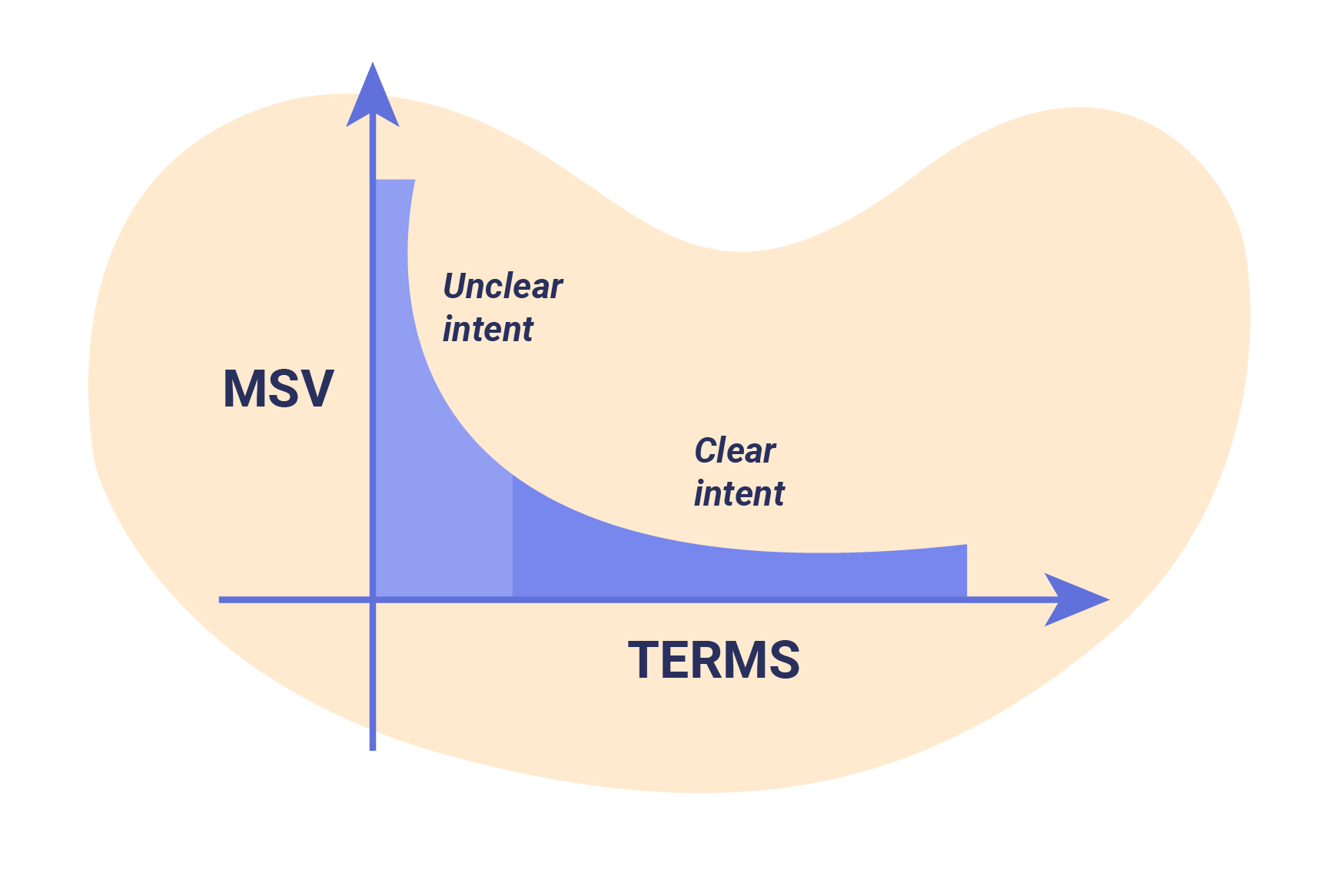
Variants of Search Intent
Informational – Know
Informational keywords (also referred to as “know” keywords) are queries that users search for when they want to find out more information about a particular topic. These kinds of keywords commonly appear in content that aims to inform or educate the searcher who has identified a problem and is looking for a way to find the solution to it.
Example: benefits of cocoa powder

Informational – Know Simple
A know simple query is a type of “know” query that seeks for a specific answer like a fact. The answer to these kinds of queries should be concise, complete and should be displayable in a small amount of space. Know simple queries are usually presented as questions, however, this doesn’t always have to be the case (see example).
Example: “define chocolate” and “what is chocolate made of” have the same user intent.
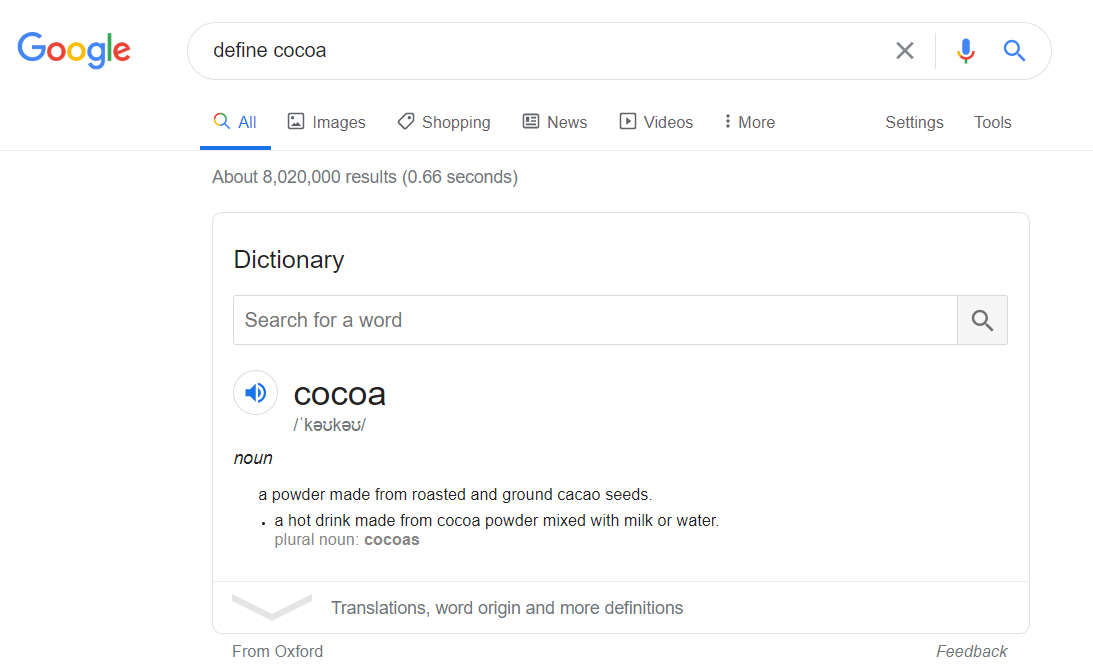
Transactional – Do
Transactional keywords (also known as “do” keywords) round off the purchasing funnel and are used when the searcher is ready to make a purchase or perform an activity on a mobile device. At this stage, the searcher has already made a decision on what they want to buy (or do), and so use specific keywords to compare products/services from several results to help them make their final decision on where to place an order.
Example: premium dark chocolate
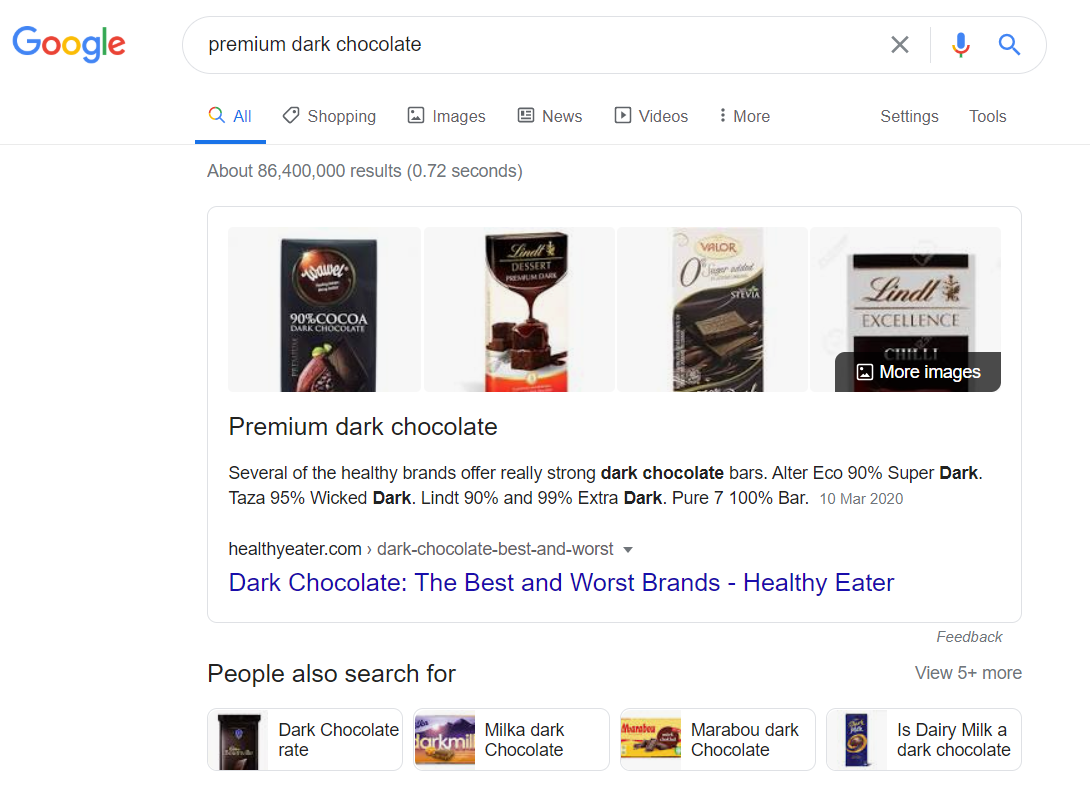
Navigational – Website Query
Website queries (or “commercial” keywords) are search terms used for when the searcher wants to visit a website in order to obtain more information about a brand or product and determine whether they offer the best solution for the problem at hand.
Example: lindt milk chocolate
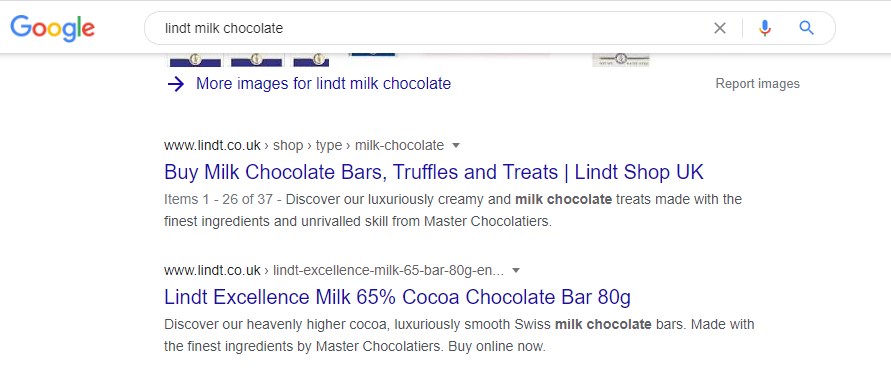
Navigational – Visit in Person
Visit in Person queries (or “visit queries”) are search queries commonly used on mobile devices that signal that the searcher wants to visit or find a location near to them.
Example: chocolate factory near me
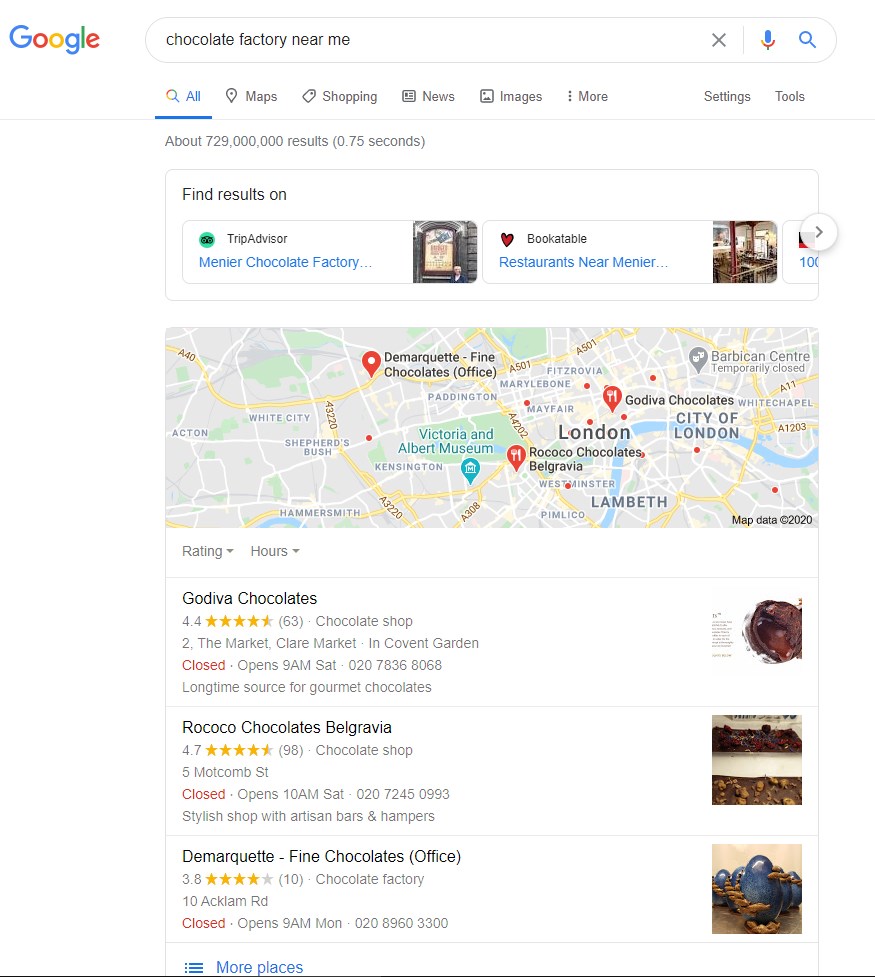
Disambiguating Ambiguous Search Queries
In some cases, the search intent behind a particular query isn’t always obvious. As we’ve seen from our Types of Keywords chapter, long-tail keywords tend to have a more specific search intent than broader terms. Broad search queries tend to be more difficult to pinpoint because they are usually being made by unqualified users who perhaps may not be familiar with the context of the search themselves.
In this section, we’ll look at two ways Google looks at disambiguating search queries that are ambiguous: semantic interpretation and context.
Semantic Interpretation
Google understands that searches can have more than one meaning and can be interpreted differently.
Take the query “How long is Harry Potter?”.
Is this query referring to:
- The seven books?
- The eight films?
- The rides in the theme parks?
- The audiobooks?
- The character itself?
In July 2019, Google was granted a patent titled “Evaluating semantic interpretations of a search query”, which focuses on looking at evaluating the different semantic interpretations of a query.
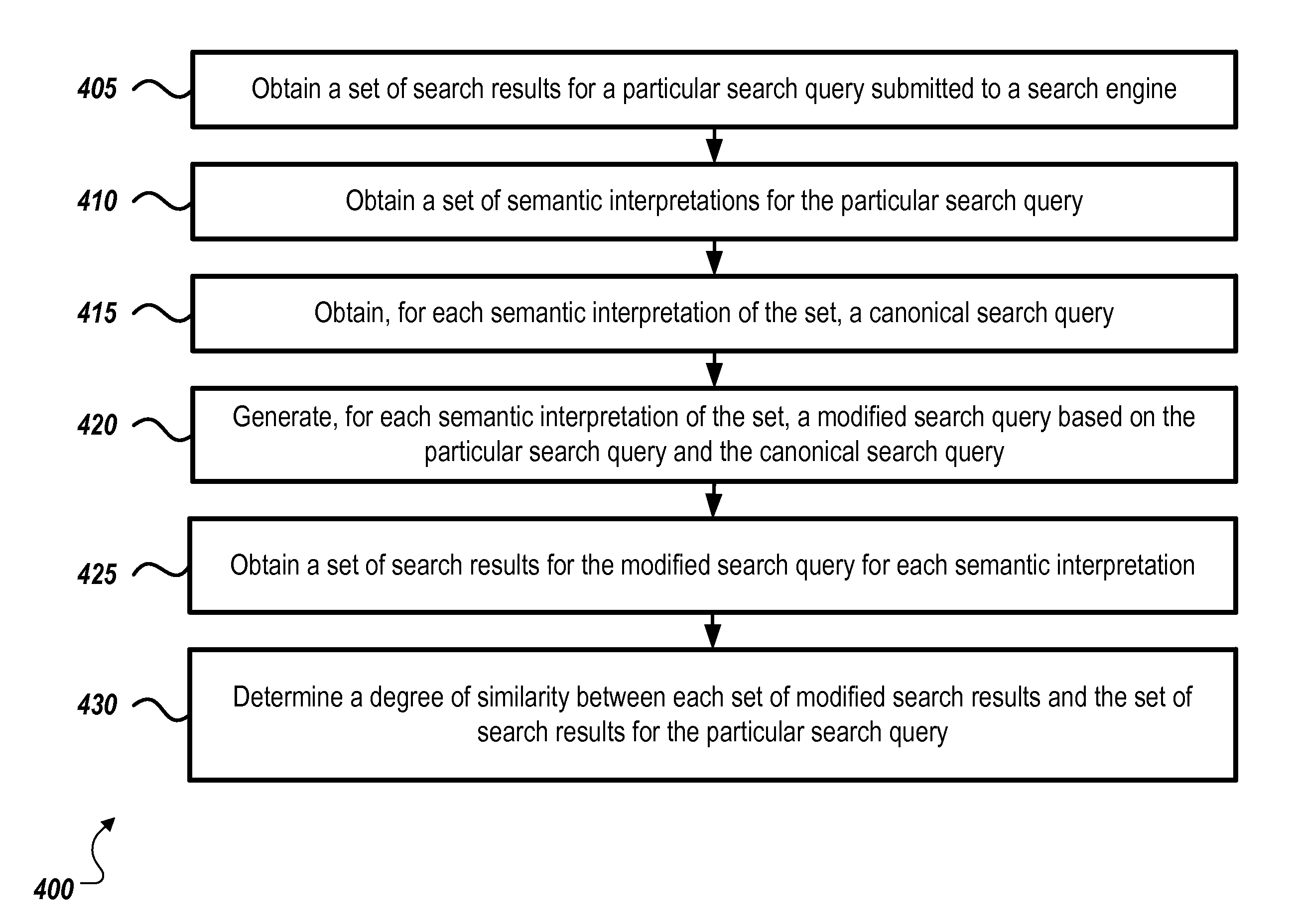
Click to enlarge.
Source: https://patentimages.storage.googleapis.com/d8/ab/03/af053534821815/US20160078131A1-20160317-D00000.png
The process for the system is outlined as follows:
- Determine one or more semantic interpretations for the user’s search query where each of these interpretations is associated with at least one canonical query.
- For each semantic interpretation, a modified search query is generated based on the original search query and the associated canonical query.
- Search results are then obtained for the particular search query and the modified search queries.
- The search results of each modified search query and the search results of the original search query are compared to evaluate the semantic interpretation associated with each modified search query. For example, each semantic interpretation can be ranked or validated with a confidence score.
- Different semantic interpretations for the original ambiguous query can be compared, and a semantic interpretation for the original search query may be selected based on the comparison.
Let’s see how this applies to our Harry Potter example which is taken from the patent.
With the query “How long is Harry Potter?”, the words “Harry Potter” are ambiguous as they may refer to the books, films, audiobooks etc.
Therefore, a different interpretation can be applied depending on the topic that the user intended to refer to within the query.
For instance, if the user was referring to one of the books, then it is likely that they were interested in the number of words of pages, whereas if it were the films, then the user may want to know about the runtimes.
With that in mind, the system would approach this example as follows:
The Semantic Interpretations (each of which are assigned a confidence score) for the query “how long is Harry Potter” may be:
- How long is the Harry Potter book?
- How long is the Harry Potter film?
- How tall is Harry Potter?
- How old is Harry Potter?
The canonical query might be “how many minutes is the film <NAME OF FILM ENTITY>?”
This would generate a modified search query like “how many minutes is the film Harry Potter”
A modification may also involve rewriting the original query to match a canonical query: “how long is the film Harry Potter” to “how long is the Harry Potter film” to match the canonical query “how long is the film”
The system would then evaluate “results from the index for the one or more modified search queries associated with the semantic interpretations” by looking at engagement metrics such as click-through rate and site traffic data to decide if the modified search queries that have been generated are good matches for the user’s original ambiguous query.
If we look at the actual SERPs for the query, we can see that Google displays the runtime for the first Harry Potter film (followed by the runtimes of the sequels).
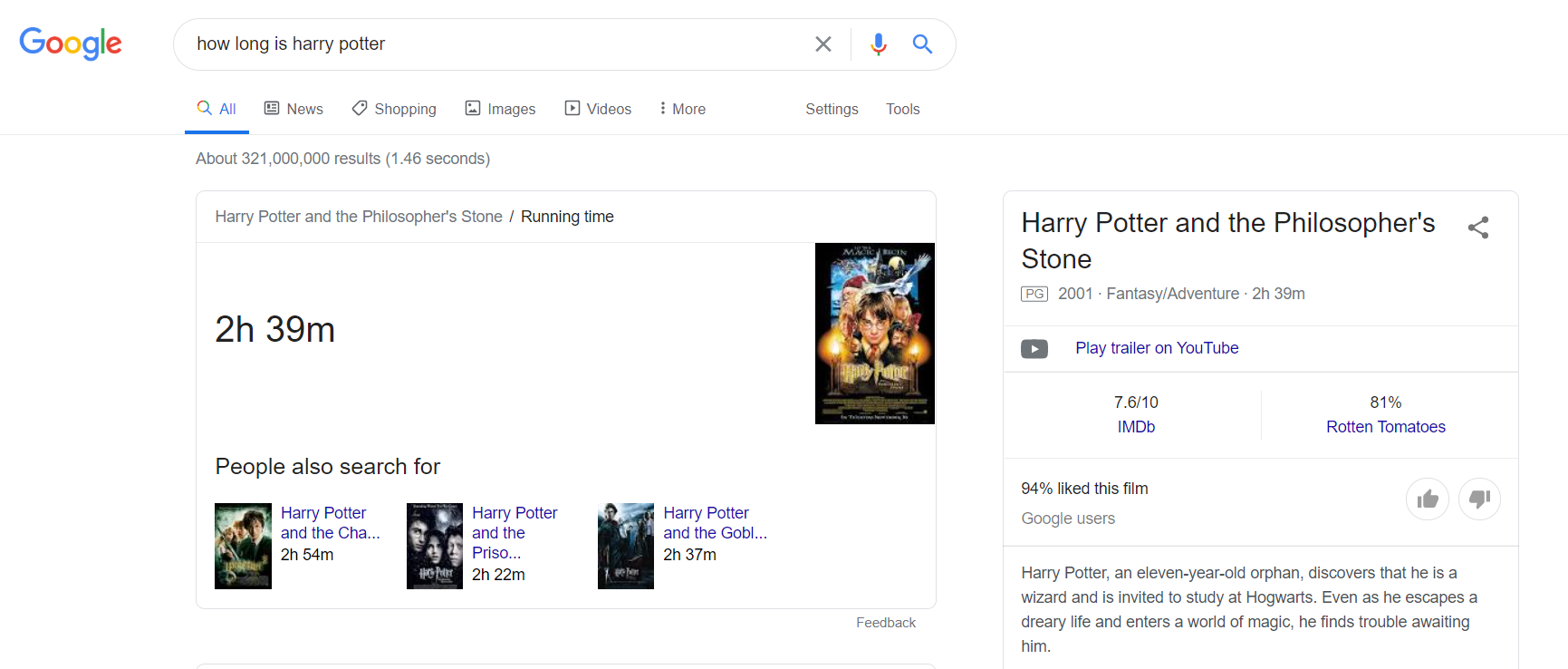
This implies that during the fourth step in the process, the Semantic Interpretation “How long is the Harry Potter film?” likely had the highest confidence score. The confidence score represents “a likelihood that the associated interpretation matches the user intent for the particular query”.
Likewise, during the fifth and sixth steps, the Interpretation and Modified Search Query would likely have had the best engagement metrics, which led the system to decide that the user is looking for the runtime for the film as opposed to the length of the book.
Therefore, the key takeaway from this patent is that Google is able to make an informed guess at the search intent for queries that are ambiguous by looking at the ways in which the query may be interpreted.
Context
Another way Google is trying to focus on providing search results that disambiguate the user’s search input is by using contextual factors.
According to a Google patent titled “Disambiguating input based on context”, a “user input is identified as being ambiguous if the system interprets it as having more than one likely intended meaning”.
An example of an ambiguous search input could be “Go to New York, New York”, which may indicate any one of the following:
- A geographic location i.e. the city of New York, N.Y.
- A song i.e. the song “New York, New York” by Frank Sinatra
- A web page i.e. a tourism page for the city of New York
The patent outlines how queries like this can be disambiguated by looking at contextual factors such as:
- The real-time location of the user’s device i.e. home, work, car etc.
- Whether or not the device is in motion i.e. accelerating, stationary etc.
- Recent activity on the device i.e. social network activity, emails (and telephone calls) sent/received etc.
This is especially important with the rise of Voice Search, where Google needs to be able to distinguish the difference between searches like “search for sail/sale info” where “sail” and “sale” are phonetically the same. Likewise, the word “sale” may even be determined as “sell” by the system.
For example, if a user provides the input “traffic”, the system may be able to deduce the context of the search even if external factors such as ambient noise from the car results result in the query being interpreted as “graphic” instead of “traffic”. This is because Google can detect that the device is travelling at a high rate of speed and that the user may, in fact, be in a car, and as a result, still be able to disambiguate the query and provide the correct results.
What this patent illustrates, is that Google understands that search behaviour is shifting in a direction that means that external factors such as our location and even our calendar information impacts the way we search. As a result, Google is learning how best to interact and interpret our search queries just as we’re trying to learn how best to interact with our own devices.
We can see this in Figure 3 of the patent which details at which steps the system takes in order to disambiguate the user’s search input.

Click to enlarge.
Source: https://patentimages.storage.googleapis.com/db/4c/3f/9e3c9241cef8d8/US20120035924A1-20120209-D00005.png
The key takeaway here, as an SEO, is that ambiguous search queries (and by extension intent), extend beyond just broad search terms and that Google is constantly getting better at identifying contextual factors that influence our search behaviour.
Optimising for Latent Intent
It’s no secret that Google is constantly evaluating and re-evaluating the SERPs in accordance with what it thinks is the latent intent for a particular query at a given point in time. We’ve established that it does this by looking at what it thinks the user’s search intent for that keyword is – but what happens if sentiment changes? What if we were able to predict which sentiment Google is going to favour during a particular season?
The image below, taken from a tweet by JR Oakes shows how rankings for a particular search term (most likely a broad, high volume keyword) changed over a period of time. Notably, we can see that the site’s visibility shot up for just a month during the holiday season before plummeting back down again.
Wow. This is interesting. This is Google serps responding to seasonality. eg. The intent changes based on time of year, and so do rankings. pic.twitter.com/IHEhg6NWbY
— JR Oakes (@jroakes) July 19, 2018
And an example from our own monitoring – black game console.
November 2018 – just before Black Friday and there are only 2 strictly informational results, the rest is mainly transactional with buying intent:
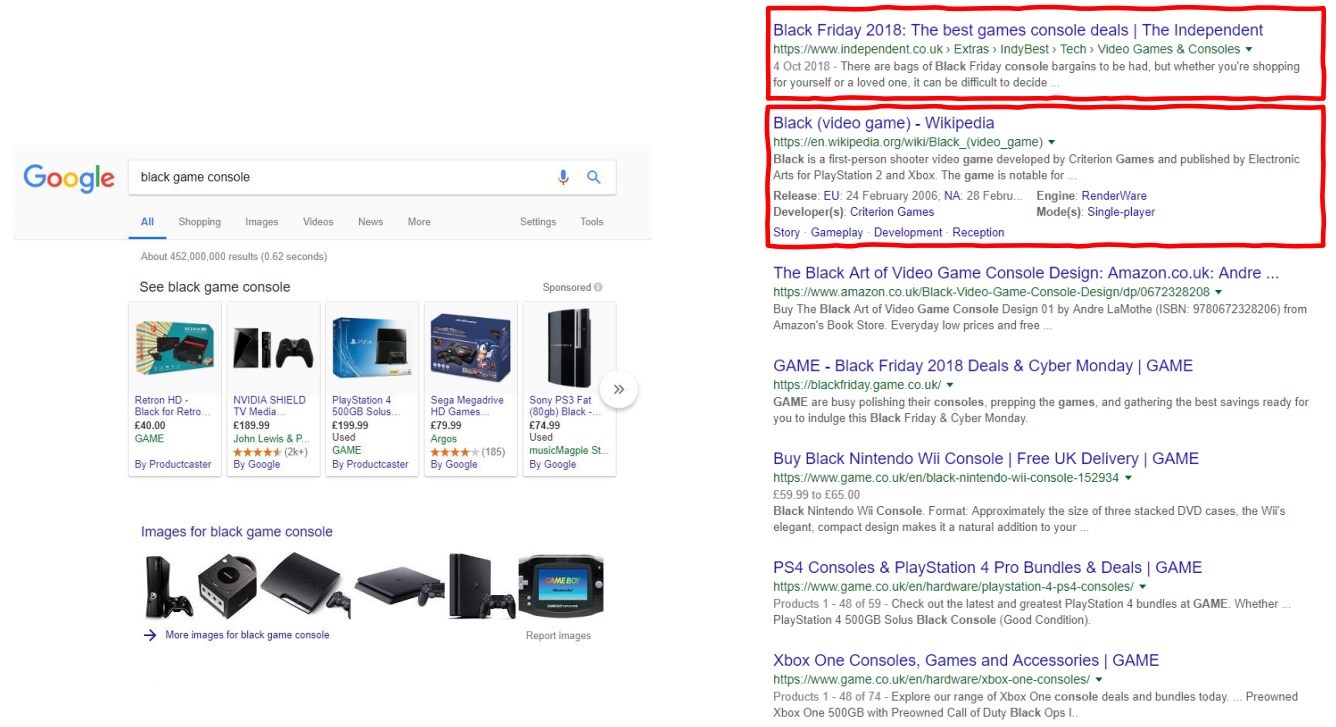
October 2019 – it’s more than a month to Black Friday and there are still 6 strictly informational, research-focused results, plus a bunch of other SERP features (Top Stories, Videos) that have a chance to distract users, so they’d be not good around an important time when SERPs were focused on transactions:
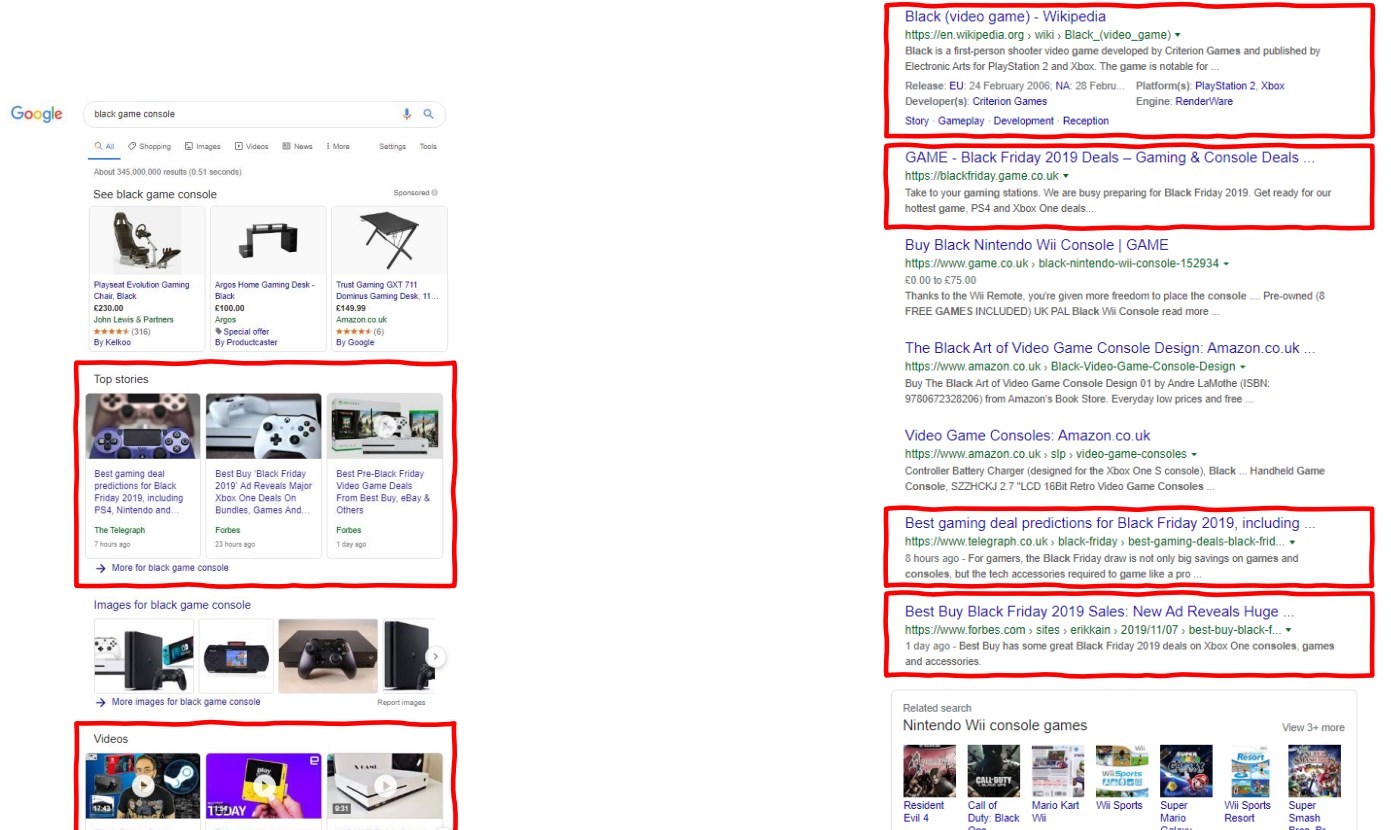
How Does User Intent Influence the SERPs?
As we’ve already discussed in the previous section, with broad terms that have high search volumes like “chocolate”, it’s difficult to pinpoint exactly what the search intent for the query is. As a result, you’ll see something like the below, where Google tries to accommodate to as many intents as possible.
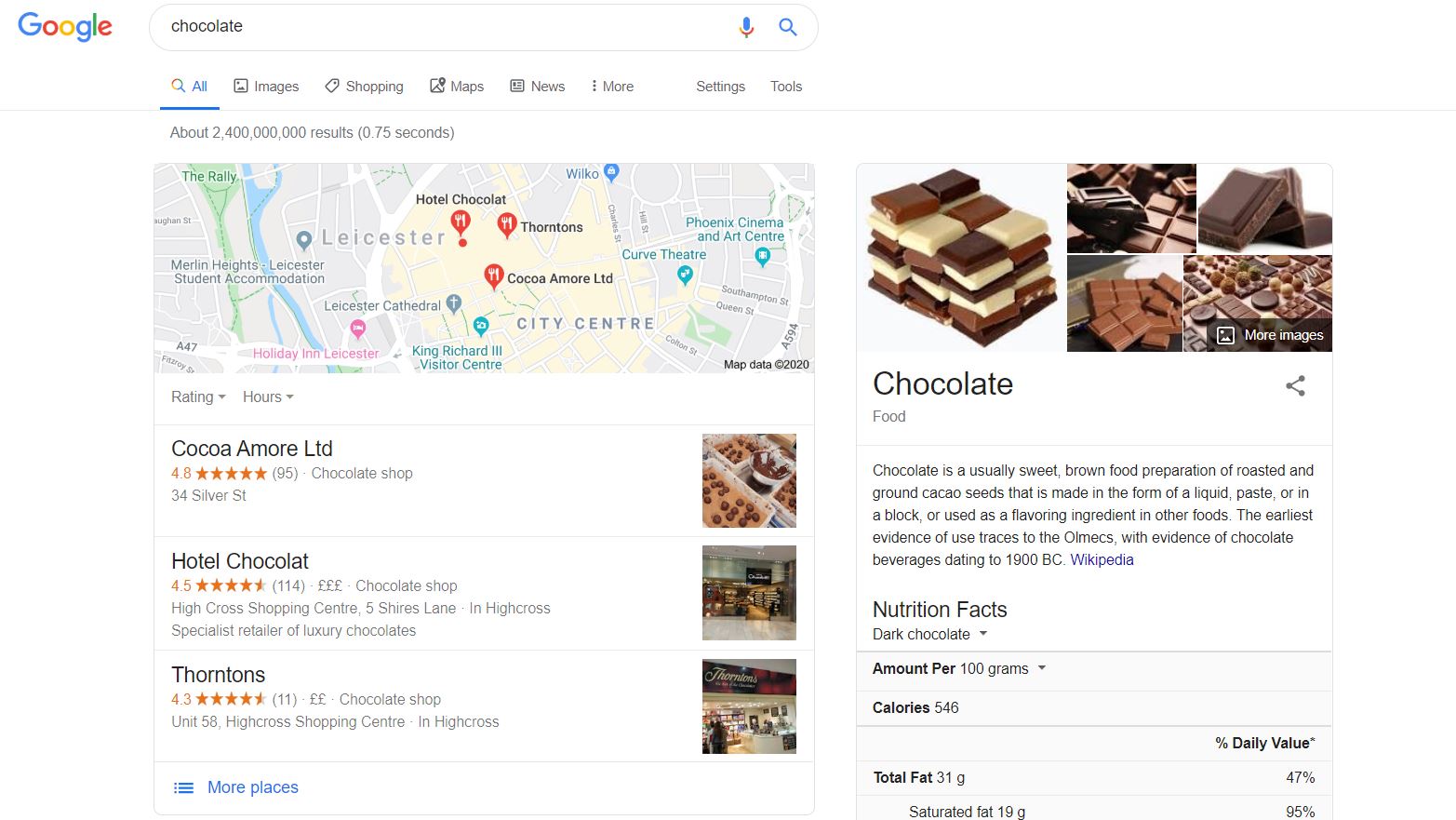
Now, if we look at the seasonal trends for the keyword “chocolate” over a twelve-month period, we can see that interest gradually builds over the year and peaks during the holiday period before plummeting back down.

Combining these two example data sets from Oakes and Google Trends, we can see that Google has likely given precedence to e-commerce websites during this period as it has identified that there is more of an intent to buy during this period. Here, Google has reacted to seasonality trends and has adapted the search results to match a change in user intent.
Of course, seasonality isn’t the only catalyst to spark a change in intent.
As Raynernomics explains in this brilliant article, other factors such as positive and negative sentiment in news-related content (based on the number of engagements such as referring domains and social shares a page gets) as well as commercial short and long-tail keywords determine whether Google adjusts the SERPs.
As a business or website owner, the key takeaway here is understanding how shifts in user intent impact the search results on Google. More importantly, though, it’s about identifying the latent intent for a particular search term, and optimising your page based on this before it becomes common knowledge – and ideally, before Google even picks up on it!